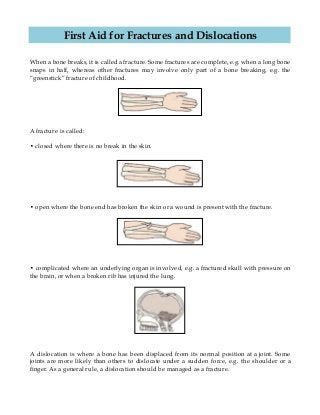First Aid For Fractures And Dislocations - WHS First Aid Kits
•
5 likes•2,536 views
When a bone breaks, it is called a fracture. Some fractures are complete, e.g. when a long bone snaps in half, whereas other fractures may involve only part of a bone breaking.
Report
Share
Report
Share
Download to read offline

Recommended
More Related Content
Viewers also liked
Viewers also liked (19)
All about Wounds(Types, Classifications, Treatments etc.)

All about Wounds(Types, Classifications, Treatments etc.)
Recently uploaded
Recently uploaded (20)
Sugar Medicine_ Natural Homeopathy Remedies for Blood Sugar Management.pdf

Sugar Medicine_ Natural Homeopathy Remedies for Blood Sugar Management.pdf
Virtual Health Platforms_ Revolutionizing Patient Care.pdf

Virtual Health Platforms_ Revolutionizing Patient Care.pdf
Improve Patient Care with Medical Record Abstraction

Improve Patient Care with Medical Record Abstraction
Breaking Down Oppositional Defiant Disorder Treatments

Breaking Down Oppositional Defiant Disorder Treatments
Integrated Mother and Neonate Childwood Illness Health Care

Integrated Mother and Neonate Childwood Illness Health Care
ASSISTING WITH THE USE OF URINAL BY ANUSHRI SRIVASTAVA.pptx

ASSISTING WITH THE USE OF URINAL BY ANUSHRI SRIVASTAVA.pptx
Occupational Therapy Management for Parkinson's Disease - Webinar 2024

Occupational Therapy Management for Parkinson's Disease - Webinar 2024
GOUT and it's Management with All the catagories like; Defination, Type, Sym...

GOUT and it's Management with All the catagories like; Defination, Type, Sym...
Jesse Jhaj: Building Relationships with Patients as a Doctor or Healthcare Wo...

Jesse Jhaj: Building Relationships with Patients as a Doctor or Healthcare Wo...
CHAPTER- 1 SEMESTER - V NATIONAL HEALTH PROGRAMME RELATED TO CHILD.pdf

CHAPTER- 1 SEMESTER - V NATIONAL HEALTH PROGRAMME RELATED TO CHILD.pdf
CHAPTER- 1 SEMESTER V NATIONAL-POLICIES-AND-LEGISLATION.pdf

CHAPTER- 1 SEMESTER V NATIONAL-POLICIES-AND-LEGISLATION.pdf
Notify ME 89O1183OO2 #cALL# #gIRLS# In Chhattisgarh By Chhattisgarh #ℂall #gI...

Notify ME 89O1183OO2 #cALL# #gIRLS# In Chhattisgarh By Chhattisgarh #ℂall #gI...
First Aid For Fractures And Dislocations - WHS First Aid Kits
- 1. First Aid for Fractures and Dislocations When a bone breaks, it is called a fracture. Some fractures are complete, e.g. when a long bone snaps in half, whereas other fractures may involve only part of a bone breaking, e.g. the “greenstick” fracture of childhood. A fracture is called: • closed where there is no break in the skin. • open where the bone end has broken the skin or a wound is present with the fracture. • complicated where an underlying organ is involved, e.g. a fractured skull with pressure on the brain, or when a broken rib has injured the lung. A dislocation is where a bone has been displaced from its normal position at a joint. Some joints are more likely than others to dislocate under a sudden force, e.g. the shoulder or a finger. As a general rule, a dislocation should be managed as a fracture.
- 2. Any injury that might involve either a fracture or dislocation should be treated with great caution. All movement of the part should be discouraged and first aid confined to providing soft padding and support in the position chosen by the victim. In a remote area, or where ambulance or medical care is likely to be delayed for an hour or more, the trained first aider may use simple immobilization techniques to reduce pain and spasm. In such cases, it is the first aider’s responsibility to monitor the circulation in any affected limb to ensure that the immobilization has not compromised blood flow or the nerve supply to an extremity. Step by Step First Aid Procedure For Fractures: Step: 1 Control any bleeding • If a wound is present, check for any bleeding. If bleeding is present it may not be severe because of pressure on nearby blood vessels from the displaced bone and soft tissues. • Apply padding around the wound, or above and below the wound. Do not apply direct pressure over the wound. • Apply a sterile dressing loosely over the injured area and bandage it in place, but avoid any direct pressure on the wound or broken bone.
- 3. Step: 2 Immobilize the injured part • Reduce the pain and the risk of further injury by supporting and immobilizing the injured area. • Effective immobilization requires an injured body part to be splinted against an uninjured body part, although this may not be necessary if an ambulance is likely to be readily available. Step: 3 Make the victim comfortable • Help the victim into the position of greatest comfort without any unnecessary movement. Use blankets, pillows or clothing for general comfort and support. • Place generous padding around the injured area and in the nearby hollows of the body, using soft towels, clothing, pillows or blankets, etc. • If outside the metropolitan area where an ambulance may not arrive within an hour, and if trained to do so, apply padding and/or splinting to stabilize and immobilize the injured part — see next section. Note: Do not move the victim or any injured part unnecessarily. Follow the next steps from our first aid hand book. You can even find first aid procedure for Fractures and dislocations that need special care like • Fracture of the face or jaw • Fracture of the collarbone or dislocation of the shoulder joint
- 4. • Fracture of the ribs • Fracture of the upper arm • Fracture or dislocation of the elbow • Fracture of the lower arm or wrist • Fracture of the hand and fracture or dislocation of a finger • Fracture of the hip or lower leg • Fracture or dislocation of the knee joint • Fracture or dislocation of the ankle, foot or toes